Module 16 - Introduction to Test Equipment
Pages i,
1-1,
1-11,
1-21,
2-1,
2-11,
2-21,
3-1,
3-11,
3-21,
3-31,
4-1,
4-11,
4-21,
5-1,
5-11,
5-21,
5-31,
6-1,
6-11,
6-21,
6-31,
6-41, Index
Chapter 2
Miscellaneous Measurements
Learning Objectives
Upon completing this chapter, you should be able to:
| - |
Matter, Energy,
and Direct Current |
| - |
Alternating Current and Transformers |
| - |
Circuit Protection, Control, and Measurement |
| - |
Electrical Conductors, Wiring Techniques,
and Schematic Reading |
| - |
Generators and Motors |
| - |
Electronic Emission, Tubes, and Power Supplies |
| - |
Solid-State Devices and Power Supplies |
| - |
Amplifiers |
| - |
Wave-Generation and Wave-Shaping Circuits |
| - |
Wave Propagation, Transmission Lines, and
Antennas |
| - |
Microwave Principles |
| - |
Modulation Principles |
| - |
Introduction to Number Systems and Logic Circuits |
| - |
- Introduction to Microelectronics |
| - |
Principles of Synchros, Servos, and Gyros |
| - |
Introduction to Test Equipment |
| - |
Radio-Frequency Communications Principles |
| - |
Radar Principles |
| - |
The Technician's Handbook, Master Glossary |
| - |
Test Methods and Practices |
| - |
Introduction to Digital Computers |
| - |
Magnetic Recording |
| - |
Introduction to Fiber Optics |
| Note: Navy Electricity and Electronics Training
Series (NEETS) content is U.S. Navy property in the public domain. |
1.
Define and explain the use of the terms "dB" and "dBm" as they apply to power measurements.
2. Describe the use of resistive loads, bolometers, and thermocouples
in power measurements.
3. Explain the measurement of mechanical rotation using the tachometer,
stroboscope, and the strobotac.
4. Explain the measurement of frequency in various ranges using vibrating
reeds, tuned circuits, heterodyne frequency meters, absorption wavemeters, cavity
wavemeters, and frequency counters.
5. Describe the use of frequency-measurement devices, oscilloscopes,
and spectrum analyzers in waveform analysis and maintenance.
6. Describe semiconductor testing and applicable terms in maintenance.
Introduction
In chapter 1, you studied test equipment Administration and the basic measurements
that all technicians are responsible for performing. Chapter 2 presents miscellaneous
measurements that are fairly common; keep in mind, however, that you may not routinely
perform these measurements in your particular job. This chapter introduces you to
several test instruments and components found in those test instruments. It will
also serve as a review of some of the basics of electronic theory related to test
equipment.
Power Measurements
You may be required to check the power consumption and the input-signal power
levels of electronic equipment. The determination of dc power is fairly simple;
recall that the unit of power, the watt, is the product of the potential in volts
and the current in amperes (P = E x I).
As discussed in NEETS, Module 2, Introduction to Alternating Current and Transformers,
the phase angle of the voltage and current must be considered for accurate ac power
measurements. The measurement of ac power is further complicated by the frequency
limitations of various power meters. If there is no phase angle difference, you
can compute ac power in the same manner as dc power; that is, by determining the
effective value of the product of the voltage and current.
For equipments that operate in the audio-frequency (AF) range, power levels have
to be determined in the performance of routine checks and during corrective maintenance
procedures.
2-1
Power measurements for AF circuits are usually indicated in terms of decibels
(dB) or decibels referenced to 1 milliwatt (dBm). Because the actual calculation
of decibel measurements is seldom required, the following explanation is somewhat
simplified. Most test equipment is designed to measure and indicate decibels directly.
This eliminates the need for you to perform complicated calculations. Nevertheless,
a basic explanation of the decibel measurement system is necessary for you to understand
the significance of dB readings and amplifier-gain ratings that are expressed in
decibels.
The Decibel System
The basic unit of measurement in the system is not the decibel; it is the bel.
The bel is a unit that expresses the logarithmic ratio between the input and the
output of any given component, circuit, or system. It may be expressed in terms
of voltage, current, or power. Most often, it is used to show the ratio between
input and output power to figure gain. You can express the power gain of the amplifier
(N) in bels by dividing the output (P1) by the input (P2)
and taking the base 10 logarithm of the resulting quotient. The formula for determining
this gain is:

If an amplifier doubles the input power, the quotient of P1 to
P2 will be 2. If you consult a logarithm table, you will find that
the base 10 logarithm of 2 is 0.3, making the power gain of the amplifier 0.3 bel.
Q-1. What is the logarithmic ratio between the input and output of
a given circuit called?
Experience has shown that because the bel is a rather large unit, it is difficult
to apply. a more practical unit, and one that can be used more easily, is the decibel
(1/10 bel). You can convert any figure expressed in bels to decibels by multiplying
that figure by 10 or simply by moving the decimal point one place to the right.
Applying this rule, we find that the above ratio of 0.3 bel is equal to 3 decibels.
The decibel (dB) cannot be used to represent actual power; only the ratio of
one power compared to another. To say that an amplifier has a 3 dB gain means that
the output power is twice the input power. This gives no indication of the actual
power represented. You must be able to state the input power for it to be meaningful.
In many applications, a mathematical expression represents the
actual power, not a power ratio. One standard reference is the dBm.
The dBm is an abbreviation used to represent power levels above or below 1 milliwatt.
Negative dBm (-dBm) represents power levels below 1 milliwatt, and positive dBm
(+dBm) represents power levels above 1 milliwatt. In other words, a dBm value is
a specific amount of power; 0 dBm is equal to 1 milliwatt. Briefly stated, the amount
of power in a given value of dBm is the power which results if 1 milliwatt is amplified
or attenuated by that dB value. For example, 40 dBm represents an actual power level
(watts or milliwatts) that is 40 dB above 1 milliwatt, whereas -10 dBm represents
a power level that is 10 dB below 1 milliwatt. The formula for finding dBm is a
variation of the dB power formula:

Q-2. What term is used to represent power levels above or below a
1-milliwatt reference?
2-2
You do not need to use the formula in most applications. The following shows
conversions of dBm to mW:
+20dBm = 100mW
+10dBm = 10mW
+7dBm = 5mW
+6dBm = 4mW
+4dBm = 2.5mW
+3dBm = 2mW
0dBm = 1mW
-3dBm = .5mW
-10dBm = .1mW
For a +10 dBm level, start with the 1 milliwatt reference and move the decimal
point one place to the right (+10 dBm = 10 mW). Another 10 dB increment brings the
power level to +20 dBm, thereby moving the decimal point another place to the right
(+20 dBm = 100 mW). For a -10 dBm level, again start with 1 milliwatt, but this
time move the decimal point one place to the left (-10 dBm = .1 mW). An additional
10 dB decrease results in another decimal point shift to the left (-20 dBm = .01
mW).
For a 3 dB increase, you double the power. For a 3 dB decrease, you reduce the
power by one-half (+3 dBm = 2 mW and -3 dBm = .5 mW). a +6 dBm level is an additional
3 dB change from +3 dBm. In this case, you just double the power level of the +3
dBm (+6 dBm = 4 mW).
Q-3. What milliwatt value is equal to +6 dBm?
The dB change can be made in either direction. For example, +7 dBm is a decrease
from +10 dBm. Reducing the +10 dBm power by one-half, we have +7 dBm, or 5 mW. a
+4 dBm power level is a 3 dB decrease from +7 dBm (+4 dBm - 2.5 mW). By using this
simple method, you can quickly find any power level that corresponds to a given
dBm.
Some test instruments you will be using are calibrated in decibels and have a
1 milliwatt zero reference level. Figure 2-1 illustrates such an instrument. Notice
that this is an ac voltmeter in which the upper scale of the meter indicates ac
voltage and the lower scale indicates decibels. The zero power-level indicator on
the decibel scale is located at, or near, center scale. If the power in the line
being measured is more than the reference value, the meter will indicate a value
to the right of the zero mark (+dB). If the power is less than the reference value,
the meter will indicate a value to the left of the zero mark (-dB). Such meters
are useful when recording measurements where a direct indication in decibels is
desired. However, you must remember that this meter is still a voltmeter and that
power measurements are not meaningful unless the circuit impedance is known. If
you feel the need to review how to calculate power in ac circuits, refer to NEETS,
Module 2.
2-3
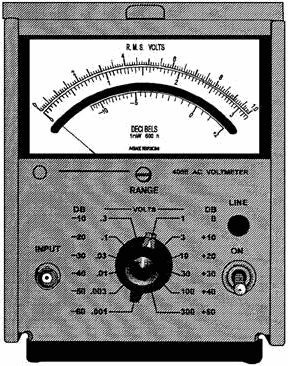
Figure 2-1. - AC voltmeter.
Measurement Methods
At radio frequencies below the UHF range, power is usually determined by voltage,
current, and impedance measurements. One common method used to determine the output
power of radio-frequency (RF) oscillators and radio transmitters consists of connecting
a known resistance to the equipment output terminals. Current flowing through this
resistance is then measured and the power is calculated as the product of I2R.
Because power is proportional to the current squared, the meter scale can be
calibrated to indicate power units directly. a THERMOCOUPLE AMMETER can be used
in this manner for measuring RF power. The resistor used to replace the normal load
is specially designed to have low reactance and the ability to dissipate the required
amount of power. Such resistors are commonly called Dummy Loads or Dummy Antennas.
Q-4. What name is given to a resistor used to replace the normal
load in a circuit?
In the UHF and SHF frequency ranges, accurately measuring the voltage, current,
and resistance is difficult. These basic measurements can vary greatly, depending
on where in the circuit the measurements are made. They are also affected by small
changes in parts placement in the vicinity of tuned circuits.
2-4
To measure the output of microwave radio or radar transmitters, you can use test
instruments that convert RF power to another form of energy, such as light or heat.
These instruments can be used to indirectly measure the power. a method used to
measure the effect of a resistor load on a stream of passing air can also be used
to indirectly measure power. Accurate measurement of large-magnitude power also
can be achieved by measuring the temperature change of a water load. The most common
type of power meter for use in this frequency range employs a BOLOMETER.
Bolometer
The bolometer is a loading device that undergoes changes of resistance as changes
in dissipated power occur. The two types of bolometers are the BARRETTER and the
THERMIsTOR. The barretter is characterized by an increase in resistance as the dissipated
power rises. The thermistor decreases in resistance as the power increases. In either
case, resistance is measured before and after the application of RF power. If the
same change in resistance is then produced by a variable dc source of power, then
the RF power is equal to the measured dc power. This relationship makes possible
the direct calibration of a bridge circuit in units of power. In other words, one
condition of balance exists when no RF power is applied; but in the presence of
power, a second condition of balance exists because of the resistance changes of
the bolometer. It is this change of resistance that is calibrated in power.
Q-5. What are the two types of bolometers?
Barretter - The construction of a typical barretter is shown
in figure 2-2. The fine wire (usually tungsten) is extremely small in diameter.
This thin diameter allows the RF current to penetrate to the center of the wire.
The wire is supported in an insulating capsule between two metallic ends, which
act as connectors. Because of these physical characteristics, the barretter resembles
a cartridge-type fuse. The enclosure is a quartz capsule made in two parts. One
part is an insert cemented in place after the tungsten wire has been mounted. In
operation, the barretter is matched to the RF line after power is applied.
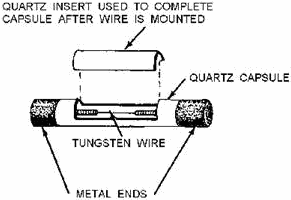
Figure 2-2. - Typical barretter.
Thermistor - a high degree of precision is made possible by
the thermistor; therefore, it is widely used. Figure 2-3 shows the typical construction
of a bead-type thermistor. The negative- temperature coefficient comes from the
use of a semiconductor as the active material. Notice that the
2-5
active material is shaped in the form of a bead. It is supported between two
pigtail leads by connecting wires. The pigtail ends are embedded in the ends of
the surrounding glass capsule.
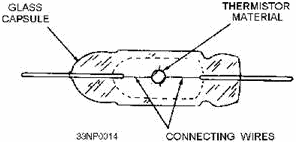
Figure 2-3. - Bead-type thermistor.
The negative-resistance temperature coefficient of thermistors is desirable.
This is because excessive power has the effect of changing the resistance of the
thermistor to an extent that causes a pronounced RF mismatch. The resulting decrease
in power transfer reduces the likelihood of burnout.
Thermistor Bridge
Figure 2-4, views a and B, is an example of a Thermistor Bridge used for RF power
measurements. a thermistor bridge circuit includes other thermistor elements, referred
to as compensating thermistors. These thermistors respond to fluctuations in ambient
temperature so that the bridge balances and calibration are maintained over a wide
temperature range. Compensating thermistors are usually in disc form so that they
can be mounted on a flat metal surface, such as a chassis or a waveguide. The thermistor
bridge in view B is located in the terminating section of a waveguide and contains
RT-2, a bead thermistor, and two compensating thermistors, RT-1 and RT-3, on the
outside of the waveguide (view A). RA-1 in view B, a calibrated attenuator, controls
the amount of RF energy applied to RT-2.
2-6
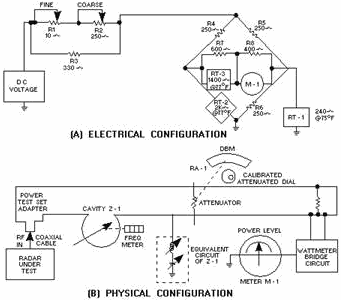
Figure 2-4. - Thermistor bridge.
Before power is applied, R1 and R2 in view a of figure 2-4 are used to adjust
the current through RT-2. When the resistance of RT-2 reaches the equivalent parallel
resistance of R6 and RT1 (122.4 ohms), the bridge is balanced. Meter M-1 reads 0
at this time. The RF signal being measured is connected to the test set and applied
via the calibrated attenuator to RT-2. This causes the temperature of RT-2 to increase,
thus reducing its resistance. The bridge becomes unbalanced, causing meter M-1 to
deflect an amount proportional to the decrease in resistance of RT-2. Meter M-1,
because of the operation of RT-2, reads average power.
Q-6. As the dissipated power increases, what effect does this have
on the resistance of a thermistor?
If the ambient temperature rises, the resistance of RT-1 decreases. This shunts
more current around the bridge network and allows RT-2 to cool. The resistance of
RT-3 decreases, maintaining meter sensitivity independent of temperature changes.
Cavity Z-1 in view B of figure 2-4 is an ABSORPTION- TYPE Frequency METER. This
type of meter will be discussed later.
Frequency Measurements
Frequency measurements are an essential part of preventive and corrective maintenance
for electric and electronic equipment. Some examples of the various frequency measurements
follow:
· Rotation frequencies of some electro-mechanical devices, such as
electric motors, must be determined.
2-7
· The output frequency of electric power generators is checked when the
engine is started and during preventive maintenance routines.
· Equipment that operates in the AF range must be adjusted to operate
at the correct frequencies.
· Radio transmitters must be accurately tuned to the assigned frequencies
to provide reliable communications and to avoid interference with radio circuits
operating on other frequencies.
· Radar sets must be properly tuned to obtain satisfactory performance.
As you can see from the above examples, frequency measurement does indeed play
a valuable role in maintenance. These measurements can be divided into two broad
categories: MECHANICAL- ROTATION Frequency measurement and ELECTRICAL-Output Frequency
measurement. Depending upon your job and/or the type of command to which you are
assigned, you may be tasked with performing one or both of these types of measurements.
Mechanical-Rotation Frequency Measurement
The rotating frequency (speed in revolutions per minute) of armatures in electric
motors and engine- driven generators, as well as the blade speed in turbines, is
measured with devices called TACHOMETERS, STROBOSCOPES, and STROBOTACS.
Tachometer
A tachometer is an instrument that measures the rate at which a shaft is turning.
Although tachometers are installed on machinery, such as generators and engines,
you may need to determine the speed of a rotating machine that is not equipped with
a tachometer. In these instances, you will be required to use a PORTABLE TACHOMETER.
Portable hand-held tachometers measure speed by direct contact with the shaft of
the measured unit. Portable tachometers are for use only during testing and should
not be used continuously. The common types of portable tachometers are the CENTRIFUGAL
and the CHRONOMETRIC.
Centrifugal Tachometer - a centrifugal-type tachometer is illustrated
in figure 2-5, view A. View B shows the internal arrangement of the centrifugal
tachometer; refer to view B in this discussion. In the centrifugal tachometer, centrifugal
force acts upon fly weights that are connected by links to upper and lower collars.
The upper collar is affixed to a drive shaft; the lower collar is free to move up
and down the shaft. a spring, which fits over the shaft, connects the upper and
lower collars.
2-8
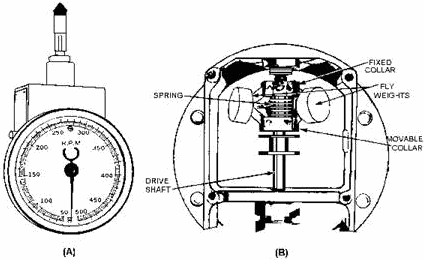
Figure 2-5. - Centrifugal tachometer.
Each portable centrifugal tachometer has a small rubber-covered wheel and a number
of hard rubber tips. You fit the appropriate tip or wheel on the end of the tachometer
drive shaft, and hold it against the shaft to measure speed of rotation. As the
drive shaft begins to rotate, the fly weights rotate with it. Centrifugal force
tends to pull the fly weights away from the center, causing the lower collar to
rise and compress the spring. The lower collar is attached to a pointer, and its
upward motion, restricted by the spring tension, causes an increase in the indication
on the dial face.
When properly used, a centrifugal tachometer will indicate correct shaft speed
as long as it is in contact with the machine shaft under test. a portable centrifugal
tachometer has three ranges: low (50 to
500 rpm), medium (500 to 5,000 rpm), and high (5,000 to 50,000 rpm).
Chronometric Tachometer - The chronometric tachometer (figure
2-6) is a combination watch and revolution counter. It measures the average number
of revolutions of a shaft per minute. The chronometric tachometer also comes with
hard rubber tips, which must be inserted over the drive shaft.
2-9
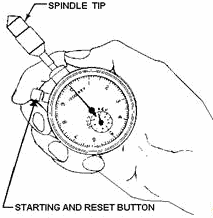
Figure 2-6. - Chronometric tachometer.
When applied to a rotating shaft, the outer drive shaft of this tachometer runs
free until a starting button is depressed to start the timing element. In figure
2-6, note the starting button beneath the index finger. The chronometric tachometer
retains readings on its dial after its drive shaft has been disengaged from a rotating
shaft and until the pointers are returned to 0 by the reset button (usually the
starting button). The range of a chronometric tachometer is usually from 0 to 10,000
rpm and from 0 to 3,000 feet per minute (fpm).
Stroboscope
The rotation frequencies of recording devices and teletypewriter motors can be
measured by the use of a STROBOSCOPE. The stroboscope is an instrument that allows
you to view rotating or reciprocating objects intermittently and produces the optical
effect of a slowing down or stopping motion. For example, electric fan blades revolving
at 1,800 rpm will appear stationary if you look at them under a light that flashes
uniformly 1,800 times per minute. At 1,799 flashes per minute, the blades will appear
to rotate forward at 1 rpm; at 1,801 flashes per minute, they will appear to rotate
backward at 1 rpm.
When the flashing rate of the light is adjustable, you can calibrate the control
in flashes (or revolutions) per minute. The stationary image you see when the rate
of the lamp and the rotational rate of a shaft are equal lets you record a very
precise speed measurement.
Strobotac
The STROBOTAC (figure 2-7) is an electronic flash device in which the flash duration
is very short (a few millionths of a second). (Table 2-1 contains a description
of the controls and indicators shown on the strobotac in figure 2-7.) Because of
this short flash duration, the strobotac can measure very rapid motion. The box
contains a swivel mount with a STROBOTRON LAMP in a reflector, an electronic pulse
generator to control the flashing rate, and a power supply that operates from the
ac power line. The flashing rate is controlled by the large knob; the corresponding
speed (rpm) is indicated on an illuminated dial that is viewed through windows in
the knob.
2-10
|















